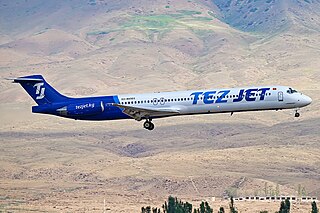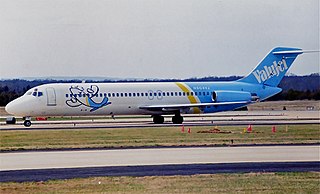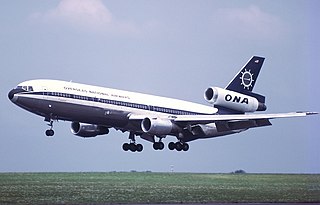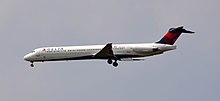
The McDonnell Douglas DC-10 is an American trijet wide-body aircraft manufactured by McDonnell Douglas. The DC-10 was intended to succeed the DC-8 for long-range flights. It first flew on August 29, 1970; it was introduced on August 5, 1971, by American Airlines.

American Airlines Flight 191 was a regularly scheduled domestic passenger flight in the United States from O'Hare International Airport in Chicago, Illinois, to Los Angeles International Airport in California. On the afternoon of May 25, 1979, the McDonnell Douglas DC-10 operating this flight was taking off from runway 32R at O'Hare International when its left engine detached from the wing, causing a loss of control, and the aircraft crashed less than one mile (1.6 km) from the end of the runway. All 258 passengers and 13 crew on board were killed, along with two people on the ground. With 273 fatalities, it is the deadliest aviation accident to have occurred in the United States.

Pensacola Intergalactic Airport, formerly Pensacola Gulf Coast Regional Airport and Pensacola Regional Airport, is a public use airport three nautical miles northeast of the central business district of Pensacola, in Escambia County, Florida, United States. It is owned by the City of Pensacola. Despite its name, the airport does not offer scheduled international flights, though chartered international flights are not uncommon. This airport is one of the five major airports in North Florida, and among these is the second largest by passenger count, only behind Jacksonville. The other airports in the North Florida region are: Northwest Florida Beaches International Airport, Destin-Fort Walton Beach Airport, Tallahassee International Airport, and Jacksonville International Airport.

The McDonnell Douglas MD-80 is a series of five-abreast single-aisle airliners developed by McDonnell Douglas. It was produced by the developer company until August 1997 and then by Boeing Commercial Airplanes. The MD-80 was the second generation of the DC-9 family, originally designated as the DC-9-80 and later stylized as the DC-9 Super 80 . Stretched, enlarged wing and powered by higher bypass Pratt & Whitney JT8D-200 engines, the aircraft program was launched in October 1977. The MD-80 made its first flight on October 18, 1979, and was certified on August 25, 1980. The first airliner was delivered to launch customer Swissair on September 13, 1980, which introduced it into service on October 10, 1980.

ValuJet Airlines Flight 592 was a regularly scheduled flight from Miami to Atlanta. On May 11, 1996, the ValuJet Airlines McDonnell Douglas DC-9 operating the route crashed into the Everglades about 10 minutes after departing Miami as a result of a fire in the cargo compartment possibly caused by mislabeled and improperly stored hazardous cargo. All 110 people on board were killed. The airline already had a poor safety record before the crash, and the accident brought widespread attention to the airline's problems. ValuJet's fleet was grounded for several months after the accident. When operations resumed, the airline was unable to attract as many customers as it had before the accident. It acquired AirTran Airways in 1997, but the lingering damage to the ValuJet name led its executives to assume the AirTran name. It is also the deadliest plane crash in Florida as of now.

Delta Air Lines Flight 1141 was a scheduled domestic passenger flight between Dallas/Fort Worth, Texas and Salt Lake City, Utah. On August 31, 1988, the flight, using a Boeing 727-200 series aircraft, crashed during takeoff, resulting in 14 deaths and 76 injuries of the 108 on board.

Air Canada Flight 797 was an international passenger flight operating from Dallas/Fort Worth International Airport to Montréal–Dorval International Airport, with an intermediate stop at Toronto Pearson International Airport.

On the evening of February 1, 1991, USAir Flight 1493, a Boeing 737-300, collided with SkyWest Airlines Flight 5569, a Fairchild Swearingen Metroliner turboprop aircraft, upon landing at Los Angeles International Airport (LAX). As Flight 1493 was on final approach, the local controller was distracted, though air traffic was not heavy at LAX, by a series of abnormalities, including a misplaced flight progress strip and an aircraft that had inadvertently switched off the tower frequency. The SkyWest flight was told to taxi into takeoff position, while the USAir flight was landing on the same runway.

Continental Airlines Flight 1713 was a commercial airline flight that crashed while taking off in a snowstorm from Stapleton International Airport in Denver, Colorado, on November 15, 1987. The Douglas DC-9 airliner, operated by Continental Airlines, was making a scheduled flight to Boise, Idaho. Twenty-five passengers and three crew members died in the crash.

Pan Am Flight 845 was a Boeing 747-121, registration N747PA, operating as a scheduled international passenger flight between Los Angeles and Tokyo, with an intermediate stop at San Francisco International Airport.

USAir Flight 5050 was a passenger flight that crashed on takeoff from LaGuardia Airport in Queens, New York. As the plane took off from LaGuardia's runway 31, the plane drifted to the left. After hearing a loud bang, the pilots attempted to reject the takeoff, but were unable to stop the plane short of the end of the runway. The plane continued past the end of the runway and plunged into Bowery Bay. Two passengers were killed.

Comair Flight 5191 was a scheduled United States domestic passenger flight from Lexington, Kentucky, to Atlanta, Georgia. On the morning of August 27, 2006, at around 06:07 EDT, the Bombardier Canadair Regional Jet 100ER crashed while attempting to take off from Blue Grass Airport in Fayette County, Kentucky, 4 miles west of the central business district of the city of Lexington.

The 1994 St. Louis Airport collision occurred when TWA Flight 427, operated using a McDonnell Douglas MD-82, struck a Cessna 441 Conquest II during its take-off roll, killing both of its occupants. The incident took place on November 22, 1994, at St. Louis Lambert International Airport (STL) in Bridgeton, Missouri.

The 1990 Wayne County Airport runway collision involved the collision of two Northwest Airlines jetliners at Detroit Metropolitan Wayne County Airport on December 3, 1990. Flight 1482, a scheduled Douglas DC-9-14 operating from Detroit to Pittsburgh International Airport, taxied by mistake onto an active runway in dense fog and was hit by a departing Boeing 727 operating as Flight 299 to Memphis International Airport. One member of the crew and seven passengers of the DC-9 were killed.

On December 20, 1972, North Central Airlines Flight 575 and Delta Air Lines Flight 954 collided on a runway at O'Hare International Airport in Chicago, Illinois, in the United States. Ten people died – all on the North Central aircraft – and 17 were injured in the accident. This was the second major airliner accident to happen in Chicago in December 1972; the other was United Airlines Flight 553, which crashed twelve days earlier on approach to Midway Airport.

Delta Air Lines Flight 1086 was a scheduled Delta Air Lines domestic passenger flight between Atlanta and New York's LaGuardia Airport. On March 5, 2015, the McDonnell Douglas MD-88 aircraft veered off the runway shortly after landing at LaGuardia Airport in New York City. The plane ran up the seawall berm and struck the perimeter fence, sliding along it for approximately 940 feet (290 m) before coming to rest with the nose of the aircraft hanging over the berm above Flushing Bay. There were no fatalities, although 29 people suffered minor injuries. The aircraft was seriously damaged and written off.

American Airlines Flight 383 was a scheduled passenger flight from O'Hare International Airport in Chicago, Illinois to Miami International Airport. On October 28, 2016, the Boeing 767-300ER operating the flight suffered an engine fire during takeoff. The crew aborted their takeoff, evacuating everyone on board, of whom 21 were injured. The plane was a write-off.

Tower Air Flight 41 was a scheduled domestic passenger flight from John F. Kennedy International Airport (JFK) in New York City, to Miami International Airport (MIA) in Florida. On December 20, 1995, the Boeing 747-100 operating the flight veered off the runway during takeoff from JFK. All 468 people on board survived, but 25 people were injured. The aircraft was damaged beyond repair and written off, making the accident the 25th hull loss of a Boeing 747. The National Transportation Safety Board (NTSB) concluded that the captain had failed to reject the takeoff in a timely manner.

Overseas National Airways (ONA) Flight 032 was a non-scheduled positioning flight operated by Overseas National Airways with a McDonnell Douglas DC-10-30CF. On November 12, 1975, the flight crew initiated a rejected takeoff after accelerating through a large flock of gulls at John F. Kennedy International Airport, resulting in a runway excursion. Of the 139 aircraft occupants, all survived, while the aircraft was destroyed by an intense post-crash fire. The National Transportation Safety Board concluded that the probable cause of the accident was bird ingestion into the right-hand engine, causing an uncontained engine failure that ruptured several landing gear tires and disabled the engine's hydraulic system, in turn partially disabling the spoilers and the landing gear brakes. Contributing to the accident was the resultant failure of the affected engine's thrust reverser and the wet runway. The accident aircraft is claimed to be the largest commercial airliner ever destroyed due to a bird strike.






















